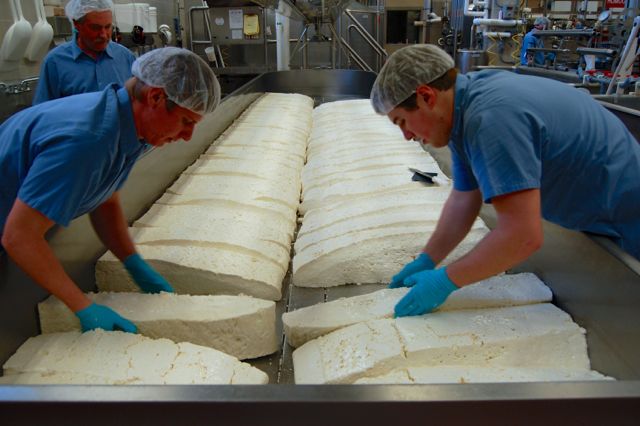
reference-image, l
(article, Tami Parr)
[%adInjectionSettings noInject=true][%pageBreakSettings nobreak=true] h3. Canned Cheese Boom and Bust Prior to the advent of refrigeration, cheese manufacturers and retailers faced a significant challenge in storing and transporting cheese. While aged cheese typically develops a relatively impervious rind, variations in manufacture, handling, and storage led more often than not to spoiled, broken, or moldy cheeses that were of poor quality and could not be sold by retailers. [[block(sidebar). h1. About the book and author For years, farmers in Oregon, Washington, and Idaho made and sold cheese to support themselves, but over time, the craft of cheesemaking became a profitable industry, and production was consolidated into larger companies and co-ops. Eventually, few individual cheesemakers were left in the region. In the late 1960s, influenced by the counterculture and back-to-the-land movements, the number of small farms and cheesemakers in the region began to grow again, initiating an artisanal cheese renaissance that continues today. Based in Portland, Oregon, Tami Parr is also the author of Artisan Cheese of the Pacific Northwest. Excerpted from Pacific Northwest Cheese: A History (2013) © Tami Parr; used with permission from OSU Press. ]] Some manufacturers packaged cheese in foil-packed wooden boxes that solved some of these problems. Canning was viewed at the time as another potential solution; by placing a perishable product in a tin can and vacuum-sealing it, a manufacturer could preserve the item indefinitely. It was only a matter of time before canning technology found its way to the cheese industry. In the dairy world, J. L. Kraft had already found considerable success manufacturing processed cheese and packaging it in tins. But packing regular, unprocessed cheese in cans proved to be more of a challenge. As early as 1904, Emil Pernot at Oregon Agricultural College studied the possibility. While Pernot had some success, his results were uneven, and he found that cans of cheddar cheese were prone to swelling and bursting, especially at high temperatures. The technology was promising enough, however, that government and university scientists around the country continued to work on perfecting the process. During the 1930s, USDA scientists developed a can with a built-in valve that allowed off-gassing as the cheese aged in the can; the resulting product was stable enough to be produced and marketed commercially. In 1933, the government’s Grove City, Pennsylvania, cheesemaking facility released 10,000 cans of cheese in an effort to test the market for the product. The prospect of a viable canning process for cheese was promising enough that the National Butter & Cheese Journal declared it “one of the most revolutionary developments that has ever taken place in the \[cheese\] industry.” A number of large commercial manufacturers seized on the new technology, including the Atlantic and Pacific Tea Co. (A&P) and Land o’ Lakes, and canned cheese began to appear in retail stores around the country. According to contemporary accounts, Portland, Oregon, was the first test market in the nation where canned cheese was specifically branded and promoted as a unique product. Several manufacturers under the United Dairymen/Darigold cooperative umbrella, including Interstate Associated Creameries, sold canned cheese in the Portland area in 1935. Interstate went all out, conducting a naming contest (Miss Ellen Dawson took first with “Golden Harvest”) and awarding prizes for recipes using the product (Savory Sandwich Buns won the top cash prize of $25). In 1938, the company shipped several cases of Golden Harvest to Philadelphia in an effort to test the market for its product on the eastern seaboard. [%image cougargold float=right width=400 caption="The cheese made at Washington State."] Meanwhile, at Washington State College in Pullman, Dr. Norman Golding was working independently, in conjunction with officials from the American Can Company, to develop a viable canned cheese product. By 1937, Golding had perfected a cheddar cheese recipe that could be successfully packaged in a regular (non-valved) can. What made Golding’s cheese different was that he used an adjunct bacterial culture that, in combination with the cheddar culture normally used in the cheesemaking process, limited the production of carbon dioxide, which had contributed to the exploding-can problem. Golding’s cheese was eventually dubbed “Cougar Gold” (the Washington State University mascot is a cougar, and the ‘gold’ is for Golding). The product continues to be manufactured and sold today in Golding’s signature cans, using milk from the school’s dairy herd managed by Animal Science Department students. Dr. Golding went on to develop and patent a technique for canning blue cheese as well. While canned cheese was the cutting-edge packaging technology of the 1930s, in the end it turned out to be a passing industry fad. Some processors balked at taking up the technology due to the expense of outfitting their factories, and others objected because the canning technology was not proprietary and could be used by any manufacturer. More significantly, canning lost considerable traction in the 1940s as Pliofilm and successor plastics took center stage, products that allowed manufacturers to age and package cheese much more simply and efficiently than in heavy, bulky metal cans. Canned cheese is still a viable technology, however, and continues to be produced in and for areas of the world where refrigeration and transportation are less reliable. [%image cheesemakers float=left width=600 caption="Cougar Gold cheesemakers at work."]

reference-image, l

cheesemakers, l

cougargold, l

feature-image, l

featurette-image, l

promo-image, l

newsletter-image, l